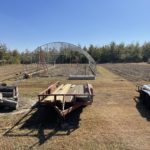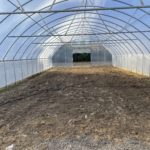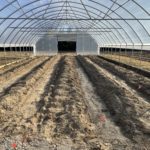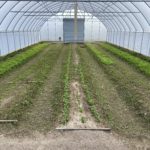Recently, we partnered with the local NRCS office to construct a high tunnel (HT) on our property. I’ve wanted to try one of these for years. The NRCS has a cost sharing program for those small farms that meet certain requirements. This help made the project very feasible from a financial standpoint, but building anything in todays work climate is a challenge. After starting the project almost a year ago and losing the first two contractors that I thought were going to help do the work, we purchased the steel to finish the high-tunnel with a third company called Tubular Structures. An independent High Tunnel erector named Jason Rose was also contracted to do the field work. The result appears to be well done and looks very good.
When I realized the first contractor was not going to finish in time for spring planting, I postponed the project until fall. Here’s what it looked like for 9 months while I waited for summer to pass. Why use up a year of plastic life for no reason? We just planted tomatoes and other veggies outside in April as we normally would and had a good crop. Now that the tunnel is ready, we’re getting ready for a fall planting of greens such as spinach, rape, kale, turnips and collards. We’ll be able to plant late and harvest later into the spring with the HT.
A HT differs from a true greenhouse in that it is a passive rather than an active system. The HT has no electricity (and therefore only passive solar heat) and uses roll up sides and large end wall doors to create ventilation when needed. A typical greenhouse will have electricity, a heater, ventilation louvers and a ventilation fan to move air through the structure and regulate temperatures. The HT is really just a tool to extend the possible vegetable production dates earlier into the spring and later into the fall/winter. In our Mississippi Delta climate, the HT also provides damaging wind and rain protection during the growing season as well. While it may protect some cold hardy veggies, it does not provide protection for warm weather plants in the coldest parts of our short winters as a true greenhouse would.
Planting for the fall will consist of plants that I would typically plant in the fall anyway. Most of these plants succumb to the few deep freezes we get each year in late January and February and only the hardiest can survive. With the HT, these greens can be planted later and will be available to eat/sell later – up until we get ready to plant summer vegetables in the early spring.
Water for the HT has to come from artificial sources. Since the rain can’t get in, we have a well that will provide water that will be delivered via a butterfly valve between each of the 6 rows of the ground space. We’ll start out by manually operating the valves and water between the rows about once a week. When summer arrives, watering frequency will have to be increased. A shade cloth will also be installed in late April to cool down the HT space and keep moisture from evaporating too quickly. We also have some automatic irrigation timers and drip tubing that can be implemented and I’ll be experimenting with different methods as I move forward.
Typically, we would plant summer veggies around the first week in April. The HT will allow us to move that date back up to 6 weeks. We’ll stagger planting from the middle of February (don’t want to risk loosing all in a late deep freeze!) and finish planting around mid march. Staggering planting dates also helps with harvest as everything does not come to fruition at the same time. One of the great advantages of the HT is the ability to begin harvest a month or more earlier than we’ve been able to in the past. Theoretically, prices for any excess we have to sell will command a better price and we’ll be eating those beautiful red tomatoes much earlier than before.
I’m currently contacting other growers in the area to do my best to learn from thier experiences and avoid mistakes they might have made. It’s exciting to have this new tool and the opportunity to try a new method of farming good food. The HT will present some new opportuniites and benefits and will undoubtedly present some unanticipated challenges. I’ll let you know how that turns out.
PS: this is a few weeks after some great neighbors helped me plant greens in the house. A recent hard freeze should have taken care of the annoying nut grass you see here. Three rows of spinach down the middle. Collards, mustard, turnips, Swiss chard, kale, carrots occupy the rest of the rows. In late February, we’ll harvest the greens that are left and start planting tomatoes and other spring veggies.





